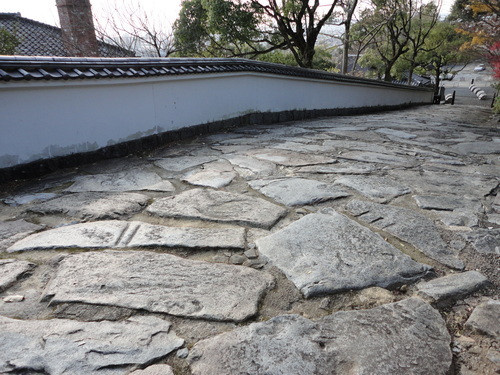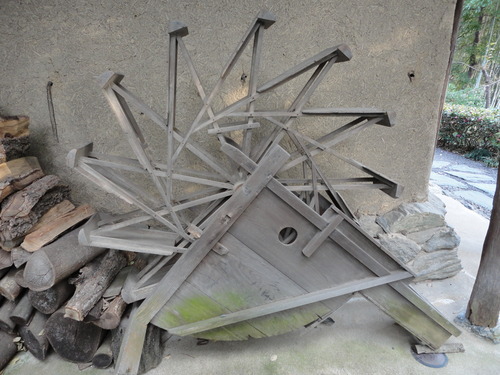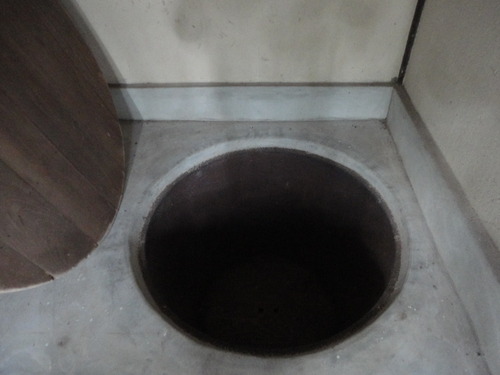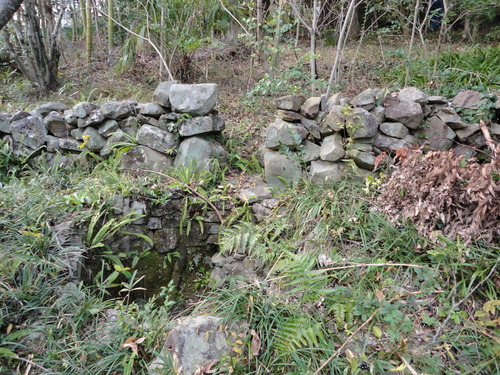2011年12月31日
Saving History
Shikoku Mura Continued
Last article, I introduced one of my favorite spots in Takamatsu, Shikoku Mura, a picturesque open-air museum full of traditional buildings and implements.

I also inspired myself to get an annual pass so I can go hiking there whenever I want. And it is good hiking!

One fact that most foreign visitors never learn, and one of the many reasons I love this museum, is that it was started by a single individual, Tatsuo Katoh. In the 1970s, Katoh was president of Katolec, a global logistics and electronics company that originated in Kagawa. This was during the period of Japan’s rapid economic growth. Realizing that in the rush towards modernization, traditional architecture was quickly vanishing from the Shikoku region, Katoh began collecting buildings, as well as the stories and implements that went with them, such as these.

A winnower (I think!)

Squid traps

Fishing boat
He gathered them from remote places all over the island to leave to posterity. Katoh had the buildings painstakingly pieced back together again on site, with great care taken to recreate the natural setting and lifestyle. This is amply demonstrated by this toilet and bath, which ias a "Registrered Tangible Cultural Property".



And by this boar fence to keep wild boars from raiding farmers' fields which comes complete with a pit in which the boars were trapped and caught for dinner.


Of course, all these buildings need regular maintenance, too, much of it requiring skills that would otherwise have died out. Such as thatching:


As well as regular gardening!

Katoh further had Japanese architect Tadao Ando design a small art museum to house his personal collection. The museum includes pieces from such contemporary artists as Picasso, Monet and Renoir as well as ancient art from Japan, China and the Middle East.

Art museum in 2002, the year it opened.

At the entrance in 2011.
Katolec continues to support the operation of Shikoku Mura to "return the company's fruits to society" (from Katolec's website). This spirit of community service is reflected in the museum's recent decision to transplant a 3-century old house from Minamisanriku, Miyagi. The thatched building was part of the Miyagi sericulture trade and had been carefully preserved for generations by a family of silk farmers. During the earthquake and tsunami of March 11, 2011, however, it suffered severe damage and neither the family nor the local community could restore it. Shikoku Mura will provide a fitting home and good care.
This is the second time Shikokumura has rescued a building outside of Shikoku. After the Great Hanshin-Awaji earthquake in 1995, the museum relocated and restored this historic lighthouse keepers’ building.


I'll be looking forward to watching the latest transplant being reconstructed over the next few years.
Hours: April-October 8:30-17:00 November to March 8:30-16:30
Access: 10 min. walk north from Kotoden Yashima Station, 15 min. walk north from Yashima JR station
Admission: Adults 800 yen; High school students 500 yen; Junior high school students 400yen,
Elementary school students 300 yen; Kindergarden and under free (Annual passes: single 3,000 yen; pair 5,000 yen)
Shikoku Mura Art Museum (includes park admission fee): Adults, 1000 yen; High school students, 600 yen; Elementary and Junior high school students, 450 yen
Parking facilities: Free parking (capacity: 20 buses and 200 cars)
Wheelchair: Partial/limited access
Last article, I introduced one of my favorite spots in Takamatsu, Shikoku Mura, a picturesque open-air museum full of traditional buildings and implements.
I also inspired myself to get an annual pass so I can go hiking there whenever I want. And it is good hiking!
One fact that most foreign visitors never learn, and one of the many reasons I love this museum, is that it was started by a single individual, Tatsuo Katoh. In the 1970s, Katoh was president of Katolec, a global logistics and electronics company that originated in Kagawa. This was during the period of Japan’s rapid economic growth. Realizing that in the rush towards modernization, traditional architecture was quickly vanishing from the Shikoku region, Katoh began collecting buildings, as well as the stories and implements that went with them, such as these.
A winnower (I think!)
Squid traps
Fishing boat
He gathered them from remote places all over the island to leave to posterity. Katoh had the buildings painstakingly pieced back together again on site, with great care taken to recreate the natural setting and lifestyle. This is amply demonstrated by this toilet and bath, which ias a "Registrered Tangible Cultural Property".
And by this boar fence to keep wild boars from raiding farmers' fields which comes complete with a pit in which the boars were trapped and caught for dinner.
Of course, all these buildings need regular maintenance, too, much of it requiring skills that would otherwise have died out. Such as thatching:
As well as regular gardening!
Katoh further had Japanese architect Tadao Ando design a small art museum to house his personal collection. The museum includes pieces from such contemporary artists as Picasso, Monet and Renoir as well as ancient art from Japan, China and the Middle East.

Art museum in 2002, the year it opened.
At the entrance in 2011.
Katolec continues to support the operation of Shikoku Mura to "return the company's fruits to society" (from Katolec's website). This spirit of community service is reflected in the museum's recent decision to transplant a 3-century old house from Minamisanriku, Miyagi. The thatched building was part of the Miyagi sericulture trade and had been carefully preserved for generations by a family of silk farmers. During the earthquake and tsunami of March 11, 2011, however, it suffered severe damage and neither the family nor the local community could restore it. Shikoku Mura will provide a fitting home and good care.
This is the second time Shikokumura has rescued a building outside of Shikoku. After the Great Hanshin-Awaji earthquake in 1995, the museum relocated and restored this historic lighthouse keepers’ building.
I'll be looking forward to watching the latest transplant being reconstructed over the next few years.
Hours: April-October 8:30-17:00 November to March 8:30-16:30
Access: 10 min. walk north from Kotoden Yashima Station, 15 min. walk north from Yashima JR station
Admission: Adults 800 yen; High school students 500 yen; Junior high school students 400yen,
Elementary school students 300 yen; Kindergarden and under free (Annual passes: single 3,000 yen; pair 5,000 yen)
Shikoku Mura Art Museum (includes park admission fee): Adults, 1000 yen; High school students, 600 yen; Elementary and Junior high school students, 450 yen
Parking facilities: Free parking (capacity: 20 buses and 200 cars)
Wheelchair: Partial/limited access
My Profile
Cathy Hirano キャシー ヒラノ
I've lived in Japan since 1978. After graduating from a Japanese university with a BA in cultural anthropology in 1983, I worked as a translator in a Japanese consulting engineering firm in Tokyo for several years. My Japanese husband and I moved to Takamatsu in 1987 to raise our two children in a slower-paced environment away from the big city pressures. We've never regretted it. I work as a freelance translator and interpreter and am involved in a lot of community work, including volunteering for Second Hand, a local NGO that supports educational and vocational training initiatives in Cambodia, and for the Takamatsu International Association. I love living in Takamatsu.
Cathy Hirano キャシー ヒラノ
I've lived in Japan since 1978. After graduating from a Japanese university with a BA in cultural anthropology in 1983, I worked as a translator in a Japanese consulting engineering firm in Tokyo for several years. My Japanese husband and I moved to Takamatsu in 1987 to raise our two children in a slower-paced environment away from the big city pressures. We've never regretted it. I work as a freelance translator and interpreter and am involved in a lot of community work, including volunteering for Second Hand, a local NGO that supports educational and vocational training initiatives in Cambodia, and for the Takamatsu International Association. I love living in Takamatsu.
Posted by cathy at 22:25│Comments(0)
※会員のみコメントを受け付けております、ログインが必要です。





